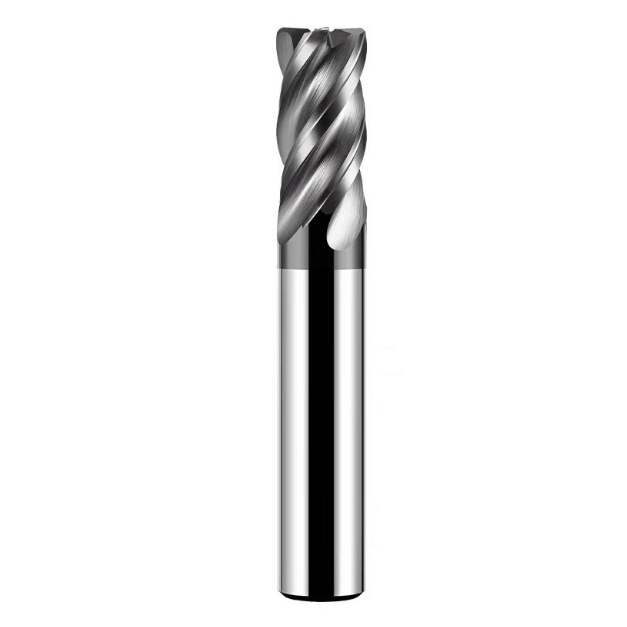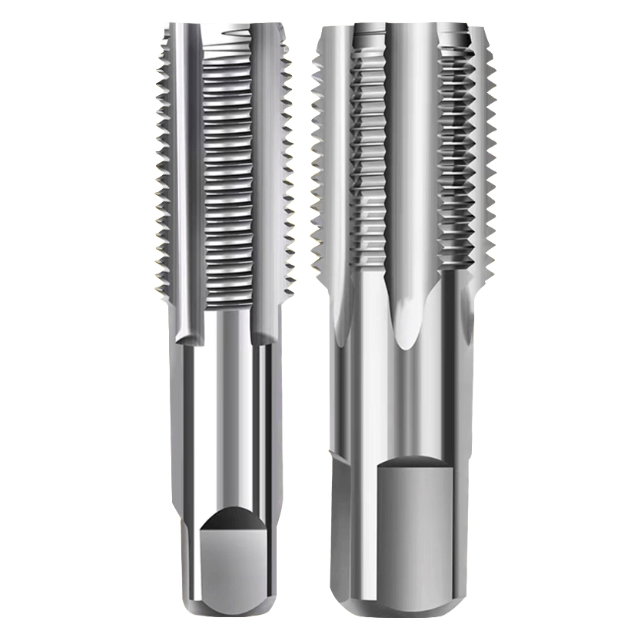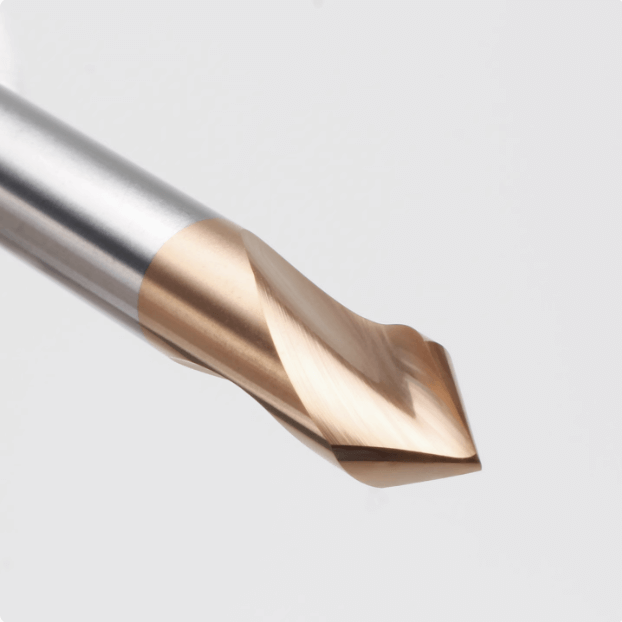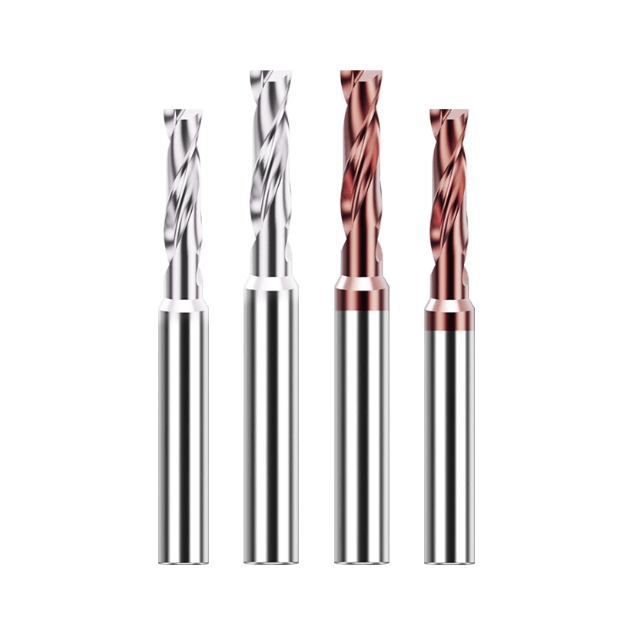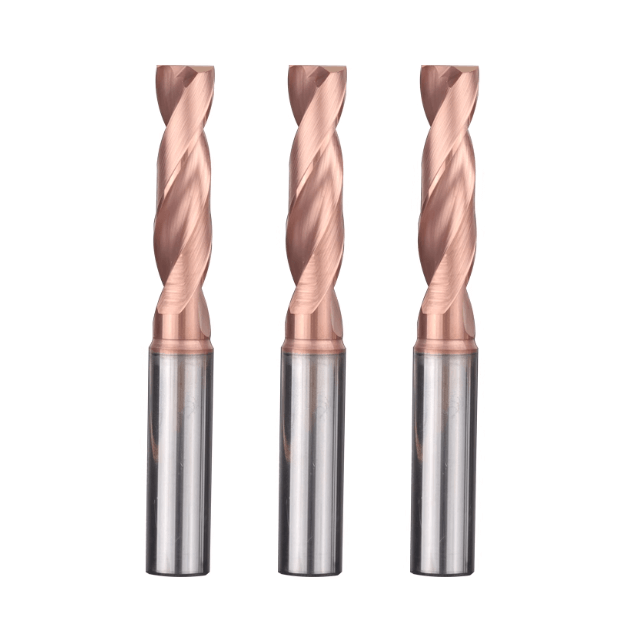Milling stainless steel is considered one of the most challenging processes in metal cutting. Due to its high strength, toughness, low thermal conductivity, and tendency to work harden, even advanced CNC machines can struggle with issues such as rapid tool wear, severe built-up edge, excessive cutting heat, and unstable surface quality. Using the wrong tool geometry, coating, or cutting parameters with end mills for stainless steel can reduce machining efficiency and lead to tool chipping or workpiece damage.
Engineers often choose carbide end mills for stainless steel to improve wear resistance and thermal stability. However, different stainless steel grades, such as 304 and 316, behave differently during cutting. For instance, 304 stainless steel is more prone to built-up edge formation, while 316 stainless steel, with higher nickel content, generates more heat, shortening tool life. Consequently, cutting speeds, feed rates, and cooling methods must be carefully adjusted for each material when CNC machining for stainless steel.
High-speed milling technology has become increasingly common. High-speed end mills for stainless steel machining can shorten cycle times and improve surface finish, but high-speed cutting places greater demands on tool material, coating adhesion, and chip evacuation. Inadequate cooling or lubrication can easily cause tool overheating, excessive wear, or chip sticking, compromising production stability.
For complex parts or non-standard geometries, custom stainless steel end mills offer an effective solution. By customizing tool geometry, flute configuration, and coating type, manufacturers can optimize cutting performance, extend tool life, and improve surface quality in CNC-machined stainless steel.
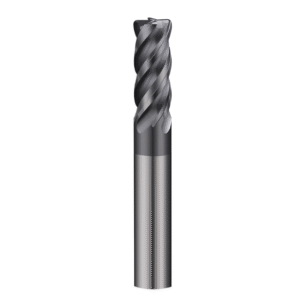
Why Stainless Steel Milling is More Challenging
Milling stainless steel is more difficult than aluminum alloys, carbon steel, or other metals. Its high strength and toughness impose higher cutting resistance on the tool. Additionally, stainless steel’s low thermal conductivity traps heat in the cutting zone, softening the cutting edge and increasing the risk of chipping. The material also work hardens easily, making subsequent cuts more difficult. Engineers must understand these characteristics and adjust cutting parameters to achieve stable cutting and longer tool life.
In CNC machining, these issues are amplified. Cutting-zone temperatures can rise rapidly. Improper cooling, tool design, or cutting parameters can accelerate tool wear, increase surface roughness, and even deform the workpiece. Milling stainless steel not only tests tool materials like carbide end mills for stainless steel but also demands optimized tool geometry, coating, and cooling strategies.
Analysis of Stainless Steel Cutting Characteristics
Stainless steel’s cutting behavior presents several challenges:
-
High ductility: Chips tend to adhere and pull, forming built-up edge and making them hard to break.
-
Poor thermal conductivity: Heat concentrates on the cutting edge, increasing wear and chipping risk.
-
Tool sticking tendency: Chips adhere to the tool, leading to rough surfaces and poor dimensional accuracy.
-
Work hardening: Improper cutting parameters or tool paths can harden the surface, increasing cutting load.
Optimizing tool material, coating, and cutting conditions is essential. For example, a carbide end mill for stainless steel with TiAlN coating can maintain hardness at high temperatures, reduce friction, minimize built-up edge, and improve cutting stability.
Common Tool Wear Patterns in Stainless Steel CNC Machining
Tool wear in stainless steel milling typically follows these patterns:
-
Tip chipping: High cutting heat and concentrated loads can cause micro-chipping, especially during interrupted cuts or hardened layers.
-
Built-up edge: Chips adhering to the rake face alter cutting angles, increase forces, and accelerate wear.
-
Heat concentration: Low thermal conductivity causes rapid tool temperature rise, leading to oxidative wear or thermal fatigue.
Using high-hardness, high-toughness end mills for stainless steel, combined with high-pressure or internal coolant systems, can reduce heat accumulation and extend tool life.
Conventional vs Stainless Steel-Specific End Mills
Conventional milling cutters (general-purpose HSS or tungsten carbide) are often optimized for low- to medium-hardness materials. They may have sharp edges but lack toughness, making them prone to chipping or overheating when milling stainless steel.
In contrast, end mills for stainless steel use tougher carbide substrates, higher helix angles for chip evacuation, and high-temperature coatings like AlTiN or TiSiN. These features ensure stable cutting, improved surface finish, and longer tool life. For deep cavity or complex structures, custom stainless steel end mills further optimize geometry and chip evacuation.
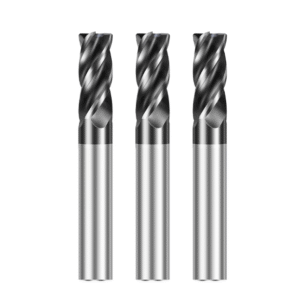
Common Problem 1: Built-up Edge and Chip Sticking
Built-up edge (BUE) and chip sticking are among the most frequent issues in stainless steel CNC machining. Stainless steel’s high ductility and toughness generate long, sticky chips that adhere to the tool’s rake face, changing cutting angles and force directions. This not only degrades surface finish but also accelerates tool wear, increases cutting temperatures, and promotes tool chipping and thermal fatigue. These effects are particularly critical in high-speed milling or deep slot operations, where precision is essential.
BUE formation is strongly influenced by cutting conditions. Low cutting speeds, insufficient feed, or inadequate cutting fluid can exacerbate chip adhesion. Engineers must consider material properties, tool selection, and optimized cutting parameters to reduce BUE and ensure stable stainless steel milling.
Causes
BUE mainly arises from stainless steel’s ductility and thermoplasticity. Heat softens the chips, which then adhere to the tool’s rake face, forming a thin layer of built-up material. High cutting temperatures reduce friction between tool and workpiece, worsening chip sticking. Over prolonged cutting, small bumps form on the cutting edge, causing surface drag marks or burrs and further destabilizing machining.
Solutions
Addressing BUE requires appropriate tools and cutting strategies:
-
Use carbide end mills for stainless steel with high-heat-resistant coatings such as TiAlN or AlTiN to maintain edge hardness and reduce chip adhesion.
-
Employ suitable cutting fluids and high-pressure coolant systems to dissipate heat efficiently.
-
Optimize cutting speeds and feed rates to prevent adhesion caused by low-speed cutting.
-
For complex shapes or deep slots, custom stainless steel end mills improve chip evacuation, minimizing BUE while maintaining precision and surface quality.
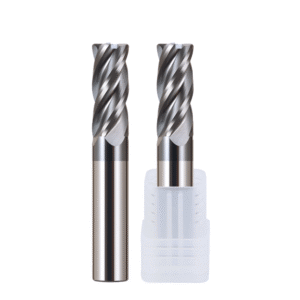
Common Problem 2: Tool Overheating and Short Tool Life
In stainless steel CNC machining, tool overheating is a major factor that shortens tool life. Stainless steel’s low thermal conductivity prevents heat from transferring quickly from the cutting zone to the workpiece or coolant, causing rapid heating of the tool edge. High temperatures accelerate tool wear, cause coating delamination, tip cracking, and, in severe cases, thermal deformation or dimensional instability on the machined surface.
Heat buildup is particularly pronounced during high-speed milling or deep-groove machining, making it a critical concern for engineers. Shortened tool life not only reduces productivity but also increases machining costs and downtime risk. Controlling tool overheating requires a comprehensive approach, including optimized tool material, geometry, coating, and cutting parameters.
Cause Analysis
The primary cause of tool overheating is localized heat accumulation at the cutting edge. Stainless steel’s poor thermal conductivity traps heat at the tool and workpiece interface, while high cutting forces and tool-material friction generate additional heat.
Machining thick or high-hardness stainless steel without proper cooling can lead to thermal expansion of the tool, altering cutting angles, increasing cutting forces, and creating a cycle that significantly shortens tool life. Improper tool geometry or coating can further exacerbate these issues.
Solutions
-
Select the right tool: Use a high-speed end mill designed for stainless steel machining. Carbide material with heat-resistant coatings can withstand high temperatures while maintaining cutting efficiency.
-
Improve cooling: Employ internally cooled tools or an oil-mist lubrication system to introduce coolant directly into the cutting zone, effectively reducing tool temperature.
-
Optimize cutting parameters: Properly adjust cutting speed (Vc), feed rate (fz), depth of cut (ap), and width of cut (ae) to reduce cutting forces and frictional heat.
-
Custom tooling: In specialized scenarios, a custom stainless steel end mill can improve chip evacuation and heat dissipation, significantly lowering the risk of overheating while maintaining high precision and efficiency.
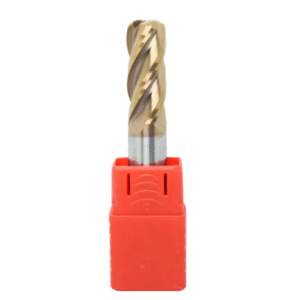
Common Problem 3: Tool Chipping and Fracture
Tool chipping and fracture are critical challenges in stainless steel CNC machining, directly affecting machining efficiency and part accuracy. Stainless steel’s high strength and toughness, combined with cutting and impact forces, can exceed a tool’s load capacity when cutting hardened layers or deep grooves. This may lead to tool tip fractures or microcracks, reducing tool life.
Improper tool material or geometry increases chipping risk, especially during high-speed or interrupted cuts. Engineers must understand stress concentrations on tools to select proper tools and optimize machining strategies.
Main Causes
-
Excessive impact loads: Deep grooves, interrupted cuts, or sudden contact with hardened areas can generate forces that exceed the tool’s fracture resistance.
-
Material and coating mismatches: Using low-toughness HSS or general-purpose carbide tools may fail under high temperature or load.
-
Improper cutting path or unstable clamping: Causes tool vibration, stress concentration, and worsens chipping risk.
Solutions
-
Tool selection: Choose a carbide end mill for stainless steel with high hardness and toughness to withstand high loads and impact.
-
Optimize cutting parameters: Reduce cutting depth and feed rate to minimize transient stress. Avoid excessive or interrupted cuts.
-
Vibration control: Use damping or anti-vibration tool holders to suppress cutting vibrations and improve stability.
-
Custom tools: For complex parts, a custom stainless steel end mill can optimize tool geometry and cutting edge design to enhance impact resistance, enabling stable, high-precision machining.
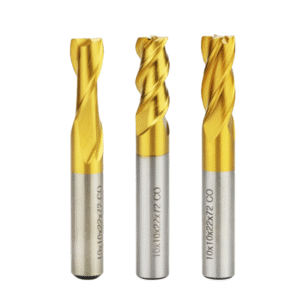
Common Problem 4: Poor Surface Finish and Excessive Burrs
In stainless steel CNC machining, poor surface finish and excessive burrs are major factors affecting part quality and assembly accuracy. Stainless steel’s high toughness and ductility cause tool sticking and wire drawing during cutting, making chip breakage difficult. This often results in drag marks, tool marks, or burrs on the workpiece surface. Surface defects are amplified when machining deep grooves, blind holes, or complex curved surfaces with inappropriate tool geometry, flute selection, or cutting parameters. For precision parts, these issues increase deburring costs and may cause dimensional deviations.
High-speed machining can exacerbate surface defects. Tool wobble, vibration, and thermal expansion during high-speed end mill machining for stainless steel can affect surface finish. Optimizing tool selection and cutting parameters is crucial to achieving a smooth surface and minimizing burr formation.
Problem Symptoms
-
Drag marks or tool marks on workpiece surfaces
-
Microburrs, especially on thin-walled or complex parts
-
Built-up edge causing increased surface roughness
-
Ripples or periodic marks from tool wear or oscillation
These issues directly impact productivity, consistency, and part functionality.
Optimization Measures
-
Use multi-flute end mills, such as 4- or 5-flute tools, to reduce cutting thickness per edge and improve surface smoothness.
-
Control tool oscillation and promptly replace worn tools to prevent vibration-induced ripples or burrs.
-
Adjust feed rates and depths of cut based on material type (304 vs. 316). For example, reduce depth of cut for 316 stainless steel to avoid burrs.
-
For deep grooves or complex surfaces, employ custom stainless steel end mills with optimized geometry and chip evacuation to improve surface finish and machining stability.
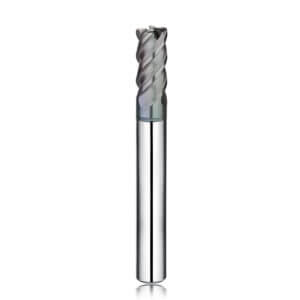
Common Problem 5: Poor Chip Control and Difficult Chip Evacuation
In stainless steel CNC machining, poor chip control and difficult chip evacuation significantly affect machining stability and tool life. Stainless steel’s high toughness and ductility often produce long, ribbon-like chips that are hard to break naturally. These chips can entangle around the tool or workpiece, increasing cutting resistance, concentrating heat, accelerating tool wear, and in severe cases, causing tool chipping or surface scratches. This issue is especially pronounced when machining deep holes, blind holes, or complex curved surfaces.
To address this, engineers typically optimize tool design, machining strategies, and cooling/chip evacuation methods to achieve smooth cutting, extend tool life, and enhance machining stability.
Cause Analysis
Chip control difficulties are primarily due to stainless steel’s material properties:
-
High toughness and ductility produce long, sticky chips that tangle easily around the tool or workpiece.
-
Limited chip evacuation space in deep cavities or complex structures worsens chip accumulation.
-
Insufficient cutting fluid or airflow increases cutting forces and frictional heat, accelerating wear.
-
Improper tool geometry, such as small helix angles or shallow chip flutes, further aggravates chip entanglement.
These factors make chip evacuation in CNC milling of 304/316 stainless steel a critical factor affecting efficiency and tool life.
Improvement Solution
To improve chip control and evacuation:
-
Use a carbide end mill for stainless steel with optimized chip flute geometry to reduce entanglement.
-
For deep cavities or complex structures, consider a custom stainless steel end mill with adjusted helix angles, flute number, and flute design.
-
Employ high-pressure coolant or forced airflow to quickly remove chips and dissipate heat.
-
Combine with high-speed end mills and optimized cutting parameters (cutting speed, feed rate, depth of cut) to improve chip evacuation, surface finish, and part dimensional accuracy.

Optimizing Strategies for Machining Different Stainless Steel Types
In stainless steel CNC machining, different grades of stainless steel require tailored machining strategies due to variations in chemical composition and mechanical properties. Although both 304 and 316 stainless steels are austenitic, they differ significantly in work hardening tendency, toughness, and thermal conductivity during cutting. These differences directly affect tool wear, chip formation, and surface finish.
To ensure machining stability and dimensional accuracy, tool selection, cutting parameters, and cooling methods must be optimized for each material. Proper use of stainless steel end mills or carbide end mills, combined with custom stainless steel end mills for deep cavities or complex geometries, can effectively improve cutting efficiency, tool life, and surface quality.
Key Points for Milling 304 Stainless Steel
304 stainless steel has a strong tendency to work-harden, especially under low cutting speeds and feed rates. To minimize the hardened layer’s effect, use moderate cutting speeds and relatively high feed rates to promote smooth chip breakage and evacuation, thereby reducing tool load.
A multi-flute carbide end mill for stainless steel can enhance cutting stability and reduce vibration impact on surface finish. During machining, applying sufficient coolant or high-pressure air helps control cutting temperature, prevent chip buildup, reduce tool sticking, and improve both dimensional accuracy and surface finish.
Machining Techniques for 316 Stainless Steel
316 stainless steel contains a higher percentage of nickel, which increases its toughness and decreases its thermal conductivity. This leads to greater heat concentration in the cutting zone, making tool overheating and chip adhesion more likely.
When machining 316 stainless steel, select a carbide end mill with high toughness and heat resistance, along with an efficient external or internal coolant system to control cutting temperature and minimize thermal deformation.
In addition, optimize the cutting depth (ap) and feed rate (fz) to avoid excessive cutting forces or interrupted cuts that can cause tool chipping. Through appropriate tool geometry design and multi-flute tool selection, you can achieve high machining stability, excellent surface finish, and improved efficiency.
Choosing the Right Mill for 304/316 Stainless Steel
Whether milling 304 or 316 stainless steel, selecting the right tool and cutting strategy is essential for stable and efficient machining.
Choose stainless steel end mills with optimized helix angles, flute numbers, and coatings suited to each material’s properties. For complex operations, custom stainless steel end mills allow engineers to fine-tune chip evacuation and cutting loads based on part geometry.
By combining proper cutting parameters—including speed, feed rate, depth, and width of cut—you can extend tool life, improve dimensional accuracy, and achieve consistent surface quality in CNC stainless steel machining.

How to Select the Right Stainless Steel Milling Cutter
After optimizing machining strategies for different stainless steels, the next step is selecting the right milling cutter. In stainless steel CNC machining, tool choice directly affects machining efficiency, tool life, and part surface quality.
Because of stainless steel’s high strength, toughness, and tendency to form built-up edges, standard milling cutters often fail to meet the demands of stable, long-term cutting.
Selecting a carbide end mill for stainless steel with optimized material, coating, and geometry ensures better thermal stability, precision, and cutting performance. For non-standard parts or complex shapes, custom stainless steel end mills can be designed to match specific workpiece geometries, depths, and chip evacuation requirements—significantly enhancing machining efficiency and tool life.
Material Selection – Tungsten Carbide vs HSS
Tool material plays a crucial role in determining cutting performance. Compared to HSS (high-speed steel), tungsten carbide maintains superior hardness and wear resistance at elevated temperatures.
Carbide tools can withstand the high cutting forces and temperatures typical in stainless steel machining, reducing chipping and wear. High-speed carbide end mills for stainless steel machining are particularly effective in deep-groove or high-speed conditions.
While HSS tools are more affordable, they tend to chip and adhere when cutting stainless steel, making them better suited for light-duty or short-cycle machining.
Coating and Geometry Optimization
Tool coating and geometry significantly influence performance in stainless steel milling. High-temperature, wear-resistant coatings such as TiAlN, AlTiN, or PVD coatings help maintain hardness, minimize adhesion, and extend tool life.
A helix angle above 45° enhances chip evacuation and promotes smoother cutting. Selecting the proper number of flutes reduces per-flute load and improves surface finish.
When machining deep holes or complex profiles, optimizing the flute number, helix angle, and flute geometry—especially through custom stainless steel end mills—can effectively improve chip evacuation, prevent jamming, and reduce tool overheating.
Advantages of Custom Tooling Solutions
Custom tooling solutions offer clear advantages in precision stainless steel CNC machining. By tailoring tool geometry and coatings to the specific material, cutting depth, and workpiece shape, custom tools achieve:
-
Efficient chip evacuation
-
Reduced cutting forces
-
Longer tool life
-
Enhanced surface quality
Such tools are especially effective for deep grooves, thin-walled parts, or high-speed machining, providing the process stability and accuracy that standard cutters cannot match.

Practical Tips for Improving Stainless Steel CNC Machining Efficiency
Improving efficiency in stainless steel CNC machining depends not only on high-performance tools but also on comprehensive strategies, including machining data management, tool monitoring, and process coordination. Due to stainless steel’s high toughness and low thermal conductivity, chip adhesion, tool sticking, and accelerated tool wear are common challenges. Without careful management of machining parameters and tool condition, achieving stable, efficient cutting is difficult.
By implementing systematic machining strategies and real-time monitoring, engineers can significantly improve efficiency while maintaining surface quality and dimensional accuracy. These practices also extend the life of carbide end mills for stainless steel, supporting both mass production and complex part machining.
Improving Stability through Cutting Data Management
Maintaining a CNC database with cutting parameters—cutting speed (Vc), feed rate (fz), depth of cut (ap), and width of cut (ae)—enables engineers to track tool wear and identify machining stability issues. Optimizing parameters for different stainless steel grades, such as 304 and 316, reduces chip buildup, tool sticking, and wear.
When combined with high-speed end mills for stainless steel machining, continuous monitoring and parameter adjustments enhance machining stability, enabling efficient and reliable production at scale.
Tool Monitoring and Maintenance Strategy
Tool condition directly impacts both accuracy and efficiency. Real-time monitoring of tool wear, tip chipping, or coating degradation allows engineers to replace or resharpen tools promptly, avoiding interruptions or scrapped workpieces.
Using a carbide end mill with wear-resistant coatings, combined with scheduled inspections and maintenance, extends tool life while maintaining stable cutting and surface quality. This strategy is especially important for long machining cycles or deep-groove operations.
Process Collaborative Optimization
Efficiency also requires a holistic approach to process coordination. Tool, machine, coolant, and machining program must work together to ensure consistent cutting forces, effective chip evacuation, and proper cooling.
Key strategies include:
-
Matching end mill geometry, helix angle, and flute count to material properties.
-
Using internal or high-pressure coolant systems to reduce cutting heat and prevent chip jamming.
-
Optimizing machining paths and tool placement to enable smooth machine motion.
-
Employing custom stainless steel end mills for complex parts, achieving optimal synergy between tool and process.
These strategies improve both production efficiency and surface quality, particularly for complex or high-speed machining tasks.

Mastering the Right Strategy Easily Overcomes Stainless Steel Milling Challenges
Stainless steel CNC machining presents challenges such as built-up edge (BUE), tool overheating, chipping, surface burrs, and chip evacuation difficulties. Each issue has specific causes and corresponding optimization strategies.
From tool selection to cutting parameter optimization, and the use of proper cooling and chip removal techniques, these practices directly affect machining efficiency, surface quality, and tool life. Understanding the characteristics of different stainless steel grades, such as 304 and 316, is essential for achieving stable and efficient production.
Summary of Core Solutions
-
Addressing chip adhesion and BUE:
-
Use a carbide end mill for stainless steel with a high-wear-resistant coating.
-
Control cutting speeds and feeds, and use high-pressure coolant to optimize chip evacuation.
-
-
Preventing tool overheating and short tool life:
-
Use high-speed end mills or tools with internal coolant.
-
Optimize cutting parameters to avoid localized heat buildup.
-
-
Reducing tool chipping and breakage:
-
Select tool materials with high hardness and toughness.
-
Avoid excessive cutting or interrupted cuts.
-
Use vibration-damping tool holders for improved stability.
-
-
Improving surface finish and reducing burrs:
-
Employ multi-edge tools, control tool oscillation, and optimize feed rates and depths for each stainless steel grade.
-
-
Enhancing chip control and evacuation:
-
Optimize chip flute geometry and use custom stainless steel end mills.
-
Implement forced chip evacuation and efficient cooling.
-
The Importance of Tool and Process Strategies
Efficient stainless steel CNC machining requires combining high-quality tools with optimized processes. Selecting the right end mill, flute count, helix angle, and coating—along with customized tooling solutions—improves cutting stability and surface quality.
Through cutting data management, tool monitoring, and process optimization, machining efficiency and stability can be continuously improved. Companies that systematically implement these strategies can overcome common stainless steel milling challenges, achieving high-precision, high-efficiency, and low-cost production, even for complex parts.



